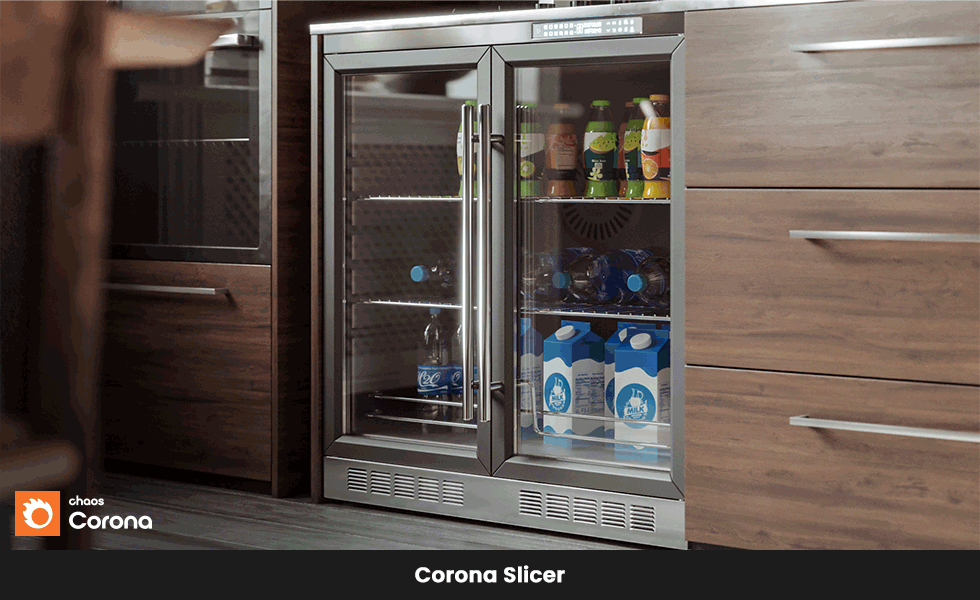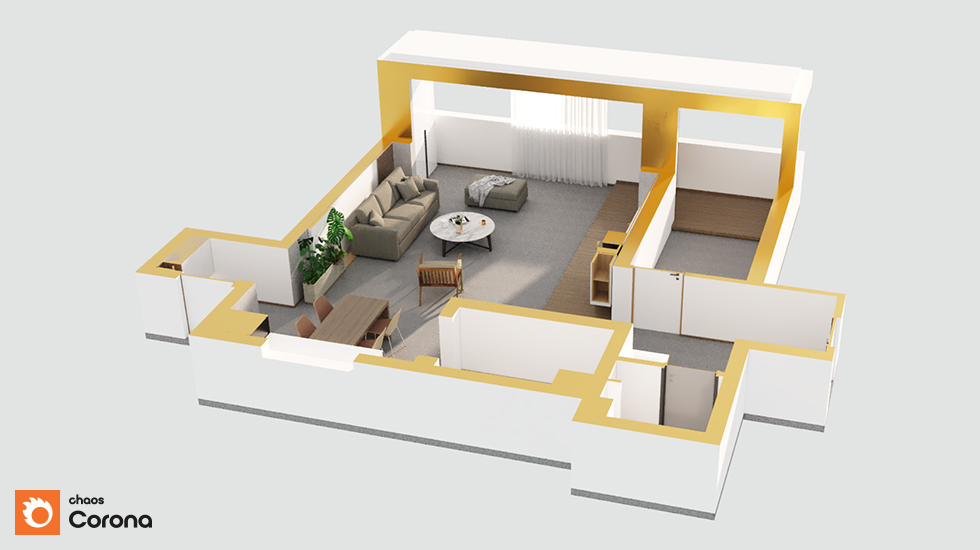Powerful workflow tools
Corona introduces many workflow tweaks which will make your life as a digital artist easier.

Corona introduces many workflow tweaks which will make your life as a digital artist easier.

Adding realistic details like trees, grass, flowers, rocks, cars in a parking lot, and fallen leaves to your scene can be tedious or impossible to place by hand. With Chaos Scatter, this isn’t a problem you’ll ever have to face.

Trees, grass, shrubs, and rocks are placed using Chaos Scatter, including limiting the trees from steep slopes, and carving out the roadway with splines
With Chaos Scatter, you can easily place trees, grass, shrubs, and rocks in your scene, limit the trees from steep slopes, and carve out the roadway with splines.
Chaos Scatter comes with a wide range of controls so you can achieve the exact results you’re looking for:

.jpg)
Now you can tile real geometry over a surface, with the same ease as you’d tile a texture. Not only does this give you far more realism than you’d ever obtain with alpha, bump, and displacement maps, it also requires far less memory than those alternatives.

To get a quick grasp of when this is useful, think of things such as:

Of course once you get to grips with the tool, you’ll start to think of many other ways in which it can be used, raising the realism of your scenes to a whole new level.

Markings on a road, cracks in concrete, smudges and dirt on glass — all of these are essential details in adding realism to your scene, and the new Corona Decal makes it easy to tackle these and more.

How does the Corona Decal improve on the old method of working with layered materials?

In this example, a patterned Chaos Scatter created this brick road, and the Decals apply over all of the individual instanced bricks without any extra work!
Sometimes, you want to see the outside and the inside at the same time. For example, you might like to slice off the top of a house to see the layout of the rooms within, or view a car with a cut away to show the engine inside, and so on. Corona Slicer will be your go-to tool for these situations!

Corona Slicer is a material you can apply to any object, turning that object into a “slicer” that will cut away geometry non-destructively at render time. You can animate this slicer object, and it all works without the inconsistencies of any sort of boolean operations in the host software.
You can control what happens to sliced surfaces, choosing to have no capping, or to create caps which can either use the material from the sliced geometry or from the material plugged into the Slicer’s Material slot.

Pro Tip: You can use the Rayswitcher when setting up the material, to make the geometry invisible to the camera but leave it still casting shadows. One use case would be wanting to cut away the roof of a house to see the interior, but not have the interior flooded by environment lighting. You can see a material set up and comparison of the results below:

Easily find and control the most important settings for Lights, Displacement, Proxies, Cameras, and Scatters using the Corona Lister and Scatter Lister. Corona 11 comes with an improved Lister feature in Cinema 4D.

Corona comes with its own proxy format, .cgeo. The format is cross platform (you will be able to use it in 3ds Max, Cinema 4D, Chaos Corona standalone, or any other future platform). It uses compression, so it is small and fast to save, load, and to upload to renderfarms. Proxy models are always converted to millimeters and properly scaled when loading into scenes that use different units.
The proxy contains human–readable metadata at the beginning of each file, for example the name of the source object and its material, making them friendly to your pipeline.
The Corona Proxy can load vrmesh proxies that contain only mesh data (additional features such as hair, levels of detail, particles, etc. are not supported).
Ever started a render, then minimized 3ds Max to get at something else on your desktop, only to find you can’t maximize Max again until the render is done? Ever started a render then wanted to check a setting in a different tab in Max, only to find that Max is locked? Those annoyances become a thing of the past, as rendering in Corona does not block the 3ds Max UI!

Cinema 4D does not natively support tooltips, but in Chaos Corona 7 and newer we have found a method for adding them anyway! We've started with tooltips for the Corona Materials, and if they prove popular we will expand that to other parts of the Corona UI.
Corona Power Tools are designed to speed up repetitive and tedious design adjustments.

Here’s an example of how you can use Object Replacer and Selection Randomizer.
We invite you to test drive Chaos Corona for FREE for 30 days without any limitations! Get the trial.